How To Connect Raspberry Pi Camera Without Module
A camera is a must-take for any Raspberry Pi owner, as it allows you to try dozens of interesting new projects. Simply I remember being puzzled with my offset photographic camera, having no idea how to plug it and configure it on my Raspberry Pi. If you lot are at present in the same situation, this commodity volition answer all your questions.
Here are the chief steps required to utilize a camera module on a Raspberry Pi:
- Plug the module to the camera port of the Raspberry Pi.
- Enable the photographic camera port in the Raspberry Pi configuration tool (Interfaces tab).
- Check that the camera is working with: raspistill -o examination.jpg.
In this guide, I'll also show you how to choose the photographic camera. I volition then explain every step of the installation and give you a few tips you need to know to relish your new device correct away.
If yous are looking to chop-chop progress on Raspberry Pi, y'all can bank check out my e-book here. It's a xxx-twenty-four hours challenge, where y'all learn one new affair every day until you go a Raspberry Pi expert. The first third of the volume teaches you the basics, but the following chapters include projects you lot tin can try on your own.
Hardware prerequisites
Download the Pi Glossary!
If you are lost in all these new words and abbreviations, request my complimentary Raspberry Pi glossary here (PDF format)!
Introduction
If you already have a camera, perfect, y'all're ready to become. Just for those who are hither to learn how a camera works on Raspberry Pi earlier buying it, I volition give y'all a few tips before placing the order.
In this office, I'll show you a few camera models I recommend and how to make your choice. We'll too have a quick expect at other useful accessories to relish your photographic camera.
Photographic camera models
Unlike USB cameras on a computer, the number of bachelor products for Raspberry Pi is quite limited.
Official Raspberry Pi Photographic camera Module
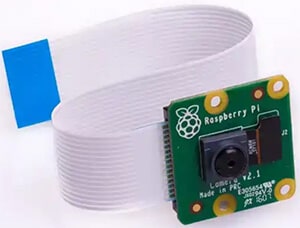
The Raspberry Pi Foundation offers 2 camera models, and I'll show you lot both. This ane was the commencement available, and has been updated in 2016 (for v2).
It's now a high-quality photographic camera with an 8 megapixel sensor that allows you lot to get Hd pictures (3280 × 2464 pixels) and videos (1080p max). This model is compatible with any Raspberry Pi model and easy to install on Raspberry Pi Os (we'll see that subsequently).
It's available on Amazon.com (check the current cost here) and the official website.
Raspberry Pi NoIR Camera Module

This one is almost the same, so I'll be quick.
The NoIR version has the aforementioned capabilities (8MP, 1080p, …).
The only difference is the ability to have infrared photographs.
The price is also a bit college, but if you have a few extra dollars available, take this 1. It's often used for security cameras or to accept photos in a depression low-cal environment. Even if you're not certain to employ this feature regularly, information technology doesn't matter, it's worth information technology (click here to check the updated price).
Raspberry Pi HQ Photographic camera
Also, the Raspberry Pi Foundation recently released a new loftier-quality camera model. It'southward similar a tiny reflex camera, and you can put additional lenses on it. It looks like this (Amazon), if you want to check it out.
Raspberry Pi Bootcamp
Sale: 10% off today.
Accept it to the side by side level.
I'm here to help you get started on Raspberry Pi.
Learn all the skills you need in the correct club.
It's more than expensive, and you don't really need information technology for virtually projects, only if you lot want something more professional, you can wait at these options.
Other models?
If yous are looking for an affordable solution, there is not really a better model than these. If y'all merely desire to have one for educational purposes, y'all tin absolutely observe a cheaper photographic camera.
For example, this i was my first camera, information technology's perfect to larn how to use a photographic camera on Raspberry Pi, but the quality is lower. It's half the price, but if you have to buy some other one a few months later, it's not worth information technology.
Other things to consider
A camera is an external device and volition often stay outside the case, so depending on what your projects are, you may need other accessories.
I will just give you a few actress links to look at, so you tin do your research easily:
- Some cases are compatible with the camera, to include the primary board and the photographic camera within. For example, the "Argon Neo" model seems perfect as there is a built-in support for the photographic camera on the example (bank check the picture on Amazon). I have a complete review most this case that you tin can find here.
- Some other thing y'all may have to consider is to continue your current case for the Raspberry Pi and use a simple holder to keep the photographic camera vertical.
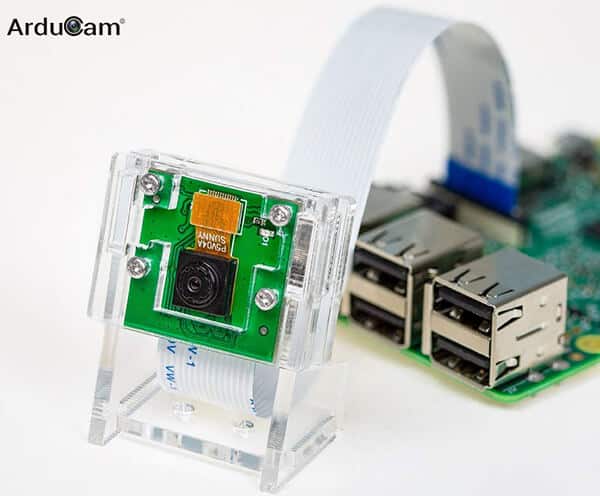
There are many similar products, you can check this i for example.
Along with the do good of keeping your current instance, it'southward also easier to use the camera if you lot can just put it on a table (for example), instead of trying to keep it in the correct place and orientation. - The last thing yous may need is another camera cable.
The included cable is fifteen cm long, that's fine for a basic usage, but you may demand to have a shorter or longer cable to fit your needs.
In this pack on Amazon, y'all accept a few cable lengths y'all tin use and change for each project (from xxx cm to i m).
Steps to Install a Camera on a Raspberry Pi
Now that you have everything you need, nosotros can start the serious part of this tutorial 🙂
Install Raspberry Pi OS
Raspberry Pi Os (ex Raspbian) is the recommended operating arrangement to install and use a photographic camera on Raspberry Pi. Everything is included and peculiarly if you cull the official model, you lot'll accept absolutely no event with it. I don't know exactly which systems are compatible, you may want to try them afterwards, only showtime with Raspberry Pi Bone for now.

I already wrote a guide on how to install Raspberry Pi Os on Raspberry Pi, experience free to check information technology if you lot're not confident with the installation.
Yous can utilize the Desktop or Light version, both are working fine with whatsoever compatible camera, so choose the 1 you adopt for your project.
The just advantage of the Desktop version is that you tin check the picture directly on Raspberry Pi Os if you have a screen in your setup.
For remote admission merely, keep the Lite version.
Later the installation, make sure y'all made these steps:
- Raspberry Pi Os installed with anything you demand (applications, network, …)
- Raspberry Pi OS configured with all your favorites settings (keyboard layout and language for example)
- System updated with the latest version of all packages
sudo apt update
sudo apt upgrade - SSH enabled to allow remote access for the first tests
sudo service ssh commencement - If you choose the Desktop version, you can as well install a remote desktop app to do everything from your computer.
Once everything is OK, yous can shut down the Raspberry Pi to install the camera
sudo shutdown -h now
Are you a fleck lost in the Linux command line? Check this article first, for the near important commands to think, and a costless downloadable cheat sheet then you lot tin take the commands at your fingertips.
Connect the camera to the Raspberry Pi
The camera installation on the Raspberry Pi is straightforward once you notice the port location:
- Take the Raspberry Pi out of its box
- Find the camera port on the Raspberry Pi (between the HDMI and jack port)
You'll discover it hands because it'due south the only one that fit the cable width, and it may exist written "Photographic camera" on the main lath. - Before plugging the cable, you may need to remove the plastic film and lightly pull the black plastic
- Plug the cable and push the black plastic to hold the cable inside
- Make sure to marshal both connectors on the same side (cable connectors on the HDMI port side)
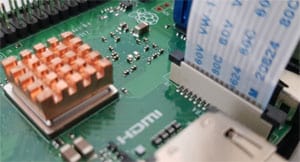
- And then I recommend starting with a rapid test before property everything in the case and/or in the holder, but to be sure that it's working 🙂
Plug all cables back (power, HDMI, network, USB …) and offset the Raspberry Pi.
If you lot have whatever incertitude, you can watch the first minute of this video to see how to plug your photographic camera:
Enable the camera port on Raspberry Pi Os
Update: If you are using the latest version of Raspberry Pi OS, you no longer need to do anything, the camera port is enabled past default. I continue the instructions for the archives, merely y'all tin can skip this footstep for a new installation.
Earlier using the camera on your Raspberry Pi, you need to enable it in your system. The camera port is disabled by default.
- Connect using SSH (you can observe useful tips here to connect via SSH from your figurer).
If you prefer, y'all tin employ a final on the Raspberry Pi OS desktop, or even use the Low-cal version. - Start the raspi-config tool
sudo raspi-config - Go to "Interface options" > "Camera"
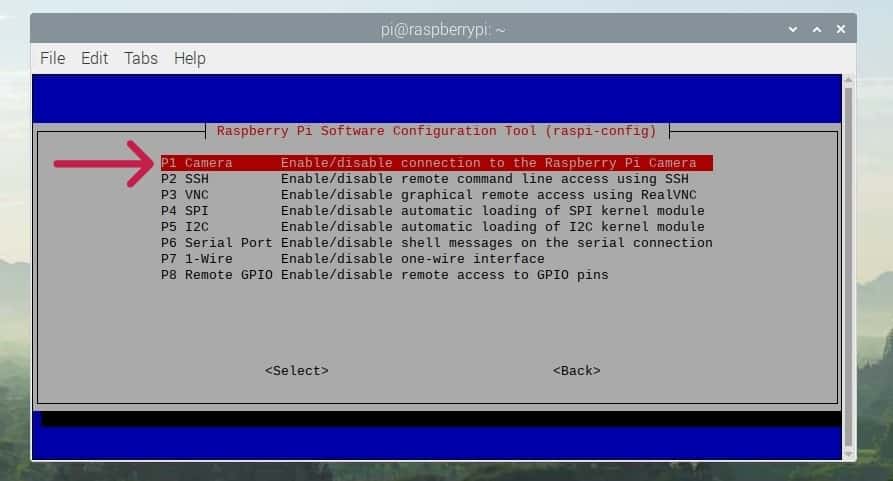
- "Would you like the photographic camera interface to be enabled?"
Yes! - Get out raspi-config and accept the reboot
That's all you need to do.
Later the reboot, the photographic camera is fix to use.
Note: If yous are new to this and employ the Desktop version, you lot don't need to blazon any command. Simply open the Raspberry Pi configuration tool (under Preferences in the main carte du jour). Click on the "Interfaces" tab and enable the camera.
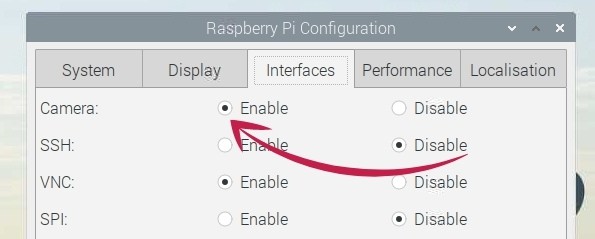
If you experience whatsoever consequence with the camera installation, or for any reason it doesn't work every bit expected, delight check this troubleshooting guide for the Raspberry Pi camera module.
Commands you tin can use on Raspberry Pi OS to manage the camera
I will now introduce two useful commands to record and see what happen on your camera.
Main your Raspberry Pi in 30 days
Sale: ten% off today.
Download the eBook.
Uncover the secrets of the Raspberry Pi in a 30 days challenge.
Learn useful Linux skills and exercise multiples projects.
Annotation that raspistill and raspivid commands are no longer supported on Raspberry Pi Bullseye and future versions. The just style to use them is to enable the legacy camera support in raspi-config, that will probably disappear shortly. I recommend switching to the new commands as soon as possible.
If you are using Raspberry Pi OS Legacy version (Buster) or have enabled the legacy support for the camera in raspi-config, you lot can nonetheless use them.
Have a photograph
The first thing you can effort is to simply have a picture of the epitome seen by the camera.
"libcamera-all the same" is the corresponding command on Raspberry Pi OS (replacing "raspistill").
Information technology's already installed on your system.
To utilise it, the basic command line is:
libcamera-all the same -o image.jpg
With -o you define the target file name (where the pictures will be saved)
It'southward possible to use a file name including the path, for instance:
libcamera-nevertheless -o ~/Pictures/mypicture.jpg
Utilise the -h parameter to brandish all the possible options for this control:
libcamera-nonetheless -h
Hither are a few interesting options yous can endeavour:
--width arg (=0) Set the output image width (0 = utilise default value) --height arg (=0) Gear up the output image top (0 = use default value) -t [ --timeout ] arg (=5000) Time (in ms) for which program runs -o [ --output ] arg Gear up the output file name -n [ --nopreview ] =arg(=i) Exercise not prove a preview window-p [ --preview ] arg (=0,0,0,0) Set the preview window dimensions, given equally x,y,width,height e.m. 0,0,640,480 -f [ --fullscreen ] =arg(=i) Employ a fullscreen preview window --qt-preview =arg(=1) Use Qt-based preview window (Alarm: causes heavy CPU load, fullscreen non supported) --rotation arg (=0) Request an image rotation, 0 or 180 --brightness arg (=0) Arrange the brightness of the output images, in the range -1.0 to ane.0 --contrast arg (=i) Arrange the contrast of the output epitome, where 1.0 = normal dissimilarity --saturation arg (=1) Arrange the color saturation of the output, where 1.0 = normal and 0.0 = greyscale -q [ --quality ] arg (=93) Set the JPEG quality parameter
Record a video
To tape a video, the command is nearly the same.
"libcamera-vid" is the corresponding control name (replacing "raspivid").
So like for pictures, to tape a video utilize:
libcamera-vid -o video.h264
Use the CTRL+C shortcut to stop the recording or add together the -t option to specify the recording elapsing.
H264 files are compatibles with VLC.
On Raspberry Pi Os Desktop:
sudo apt install vlc
Same matter to see all the parameters available, use libcamera-vid -h to become all options with a short description. Useful options are :
- –t : to choose the video duration in ms (ex: 6000 for a 6s video). This way you don't demand to use CTRL+C and can schedule the video capture with a script or cron
- -w and -h: video size (width and height)
Go files on your computer (Raspberry Pi Os Lite)
Yous may be request how to download pictures on your computer subsequently this.

The easiest fashion is to use software like FileZilla or WinSCP :
- FileZilla is a free tool available on Windows, Linux and macOS.
It'due south generally used to connect to FTP servers, merely there is an choice to apply it for SCP transfers.
You tin download the setup files here. - SCP is a secured protocol to re-create files on the network over SSH.
So, yous don't need anything else on the Raspberry Pi. - Open up FileZilla
- To attempt it speedily, you can utilize the quick connect option under the menu:

Simply in that location is also a "Site manager" to shop all your servers and connect without inbound anything. - Fill the host with the Raspberry Pi IP address.
And then the username (probably "pi") and the pi countersign - Click "Quickconnect" when prepare
- On the left side, this is your computer, scan to the path where you want to download files to (C:\Users\username\Pictures for example)
- On the correct side, it's the Raspberry Pi, browse to the location where you saved the pictures or video
- Double-click on a file to download it.
Or select multiple files, correct-click and "Download files"
Control the camera with Python
The last interesting thing I want to show you is to use an advanced programming linguistic communication (Python), to go farther with your camera and include it in bigger projects.
Alert: This script won't work on the latest Raspberry Pi Os version. You need to use the Legacy version (Buster) or enable the legacy support for the camera. At the time I'm updating this, I don't know the workaround to make this work on the latest releases.
On Raspberry Pi Os Bullseye, there is no Python interface yet. An culling to the old Picamera, imaginatively named Picamera2, is in development
Raspberry Pi
Introduction
If y'all are new to Python and desire to do more things on Raspberry, I retrieve you lot may demand to acquire information technology. Python is a central linguistic communication on Raspberry Pi (if I recollect well, the Pi from Raspberry Pi comes from Python). And the adept news is that everything is bachelor on a default Raspberry Pi OS to use Python directly (editors, compilers, basic libraries, …).
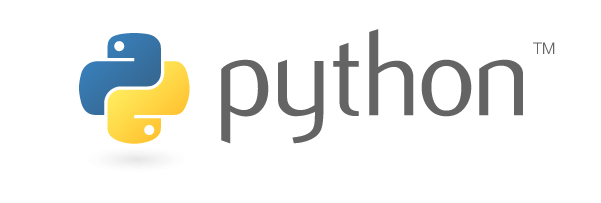
In this function, I will not teach you lot everything about Python, that's not the goal, just just how to utilize your camera with it. If you want to learn more, I have a detailed guide on how to showtime with Python hither. You can even go to this article and download my cheat sheet with the principal syntax structures to remember.
Beginning script with Python
OK, allow's showtime with the offset script to take pictures with Python. In the following steps, I continue with Raspberry Pi OS Lite. If you are on Raspberry Pi Bone Desktop, in that location are many editors you tin can use like Thonny (pre-installed) or other available with apt.
Principal Python on Raspberry Pi
Sale: x% off today.
Get the eBook.
Do more with your Raspberry Pi, learn the useful concepts and have the shortcuts.
You lot miss one-half of the fun of using a Raspberry Pi if you don't know anything about Python.
Create your first script :
- Install the Python camera library if needed (installed past default on Desktop):
sudo apt install python3-picamera - Create a new Python file:
nano first_script.py - Paste the following sample lawmaking into the file:
import picamera
with picamera.PiCamera() as camera:
photographic camera.start_preview()
camera.capture('/dwelling/pi/Images/python.jpg')
camera.stop_preview()
- Salve and get out (CTRL+A, CTRL+D)
- Create the Images folder if needed:
mkdir /home/pi/Images - Run the script
python3 first_script.py - Cheque the outcome in /home/pi/Images
You tin can see the python.jpg file with the picture yous just took
(Apply WinSCP, FileZilla or scp to copy the file on your computer and check the flick)
Information technology'southward only a basic script where you get the nuts on how to take a moving picture in Python. If y'all already know Python, y'all can do everything from here
(All available functions are in the documentation here).
Meliorate the script
At present, I'll prove you some other example, with more advanced features.
The goal here is to give y'all an extra delay after starting the script, to prepare your all-time smile earlier the photo 🙂
We'll do this in two steps, a basic one and a slightly improved ane.
- Create a new file (you tin can also edit the previous one as well-nigh zip changes for the first sample)
nano picture_delay.py - Paste these lines :
import time
import picamera
with picamera.PiCamera() as photographic camera:
camera.start_preview()
time.sleep(5)
photographic camera.capture('/dwelling/pi/Images/python2.jpg')
camera.stop_preview()
- That's almost the same script for at present
The sleep function allows you to await a few seconds (5 in the example) before continuing - Relieve and Go out (CTRL+A, CTRL+D)
- Try it :
python picture_delay.py - Did y'all have the time to exercise your best smile?
Probably, simply you lot have to keep information technology for a few seconds without knowing if the shot was taken
We'll improve that now, and add a sound when the script takes the movie
- Edit the previous file (or create a new one) :
nano picture_delay_sound.py - Paste these lines into the file :
import pygame import fourth dimension import picamera with picamera.PiCamera() every bit photographic camera: photographic camera.start_preview() fourth dimension.sleep(iv) pygame.mixer.init() pygame.mixer.music.load("flash.wav") pygame.mixer.music.play() time.sleep(1) photographic camera.capture('/home/pi/Images/python.jpg') camera.stop_preview() - Salvage and exit
- You'll probably demand to install the pygame library :
sudo apt install python-pygame - Y'all may also need to observe the wink.wav file, or utilize something else.
For bones sounds, Soundbible offer direct download, for case, this one: Soundbible clicking sound.
Many sites offering many sounds, merely nearly of them require a free account, Soundbible allows direct download without an account. - Once you find information technology, rename the wav file or edit the script, and run the script:
python3 picture_delay_sound.py - With an sound output on the Raspberry Pi, you'll hear the sound i second before the shot
That'southward it for my 2nd script. You now need to code the script corresponding to your needs. This documentation might help yous.
FAQ
Can I plug a camera on a Raspberry Pi Goose egg?
A photographic camera module can also exist used with a Raspberry Pi Zero, but a different ribbon is required. Make sure to purchase a camera module where a ribbon corresponding to your Raspberry Pi model is provided (this ane for case).
How do I know if the camera module is properly connected to the Raspberry Pi?
There is no detector or tool to know if a camera is correctly plugged. But follow the installation process and brand a exam to see if information technology works or if yous encounter any error.
Tin can I employ a USB photographic camera on my Raspberry Pi?
Every bit a whole, Raspberry Pi supports most USB cameras, and then it should be possible to use one instead of the camera module. Simply plug it to a USB port and get-go a compatible application.
You can for instance use information technology in OBS Studio, to tape or stream the video.
Thank you to all my Patrons for supporting me, helping me to keep doing this and producing even more tutorials for everyone! Thanks to anybody supporting me there.
Decision
Get My Cheat Sheet!
Grab your gratuitous PDF file with all the commands you need to know on Raspberry Pi!
I hope you enjoyed this introduction on how to install and configure a camera on Raspberry Pi. If you make bigger projects with your photographic camera, information technology would exist squeamish to share them here with the states, I'll love information technology!
If you are looking for projects ideas you can exercise with a camera, click on the link to find my recommendations, you will come across that everything is possible 🙂
Raspberry Pi Resources
Non certain where to start?
Empathise everything about the Raspberry Pi, finish searching for help all the time, and finally enjoy completing your projects.
Watch the Raspberry Pi Bootcamp course now.
Main your Raspberry Pi in xxx days
Don't want the basic stuff only? If yous are looking for the best tips to become an expert on Raspberry Pi, this book is for y'all. Learn useful Linux skills and exercise multiple projects with step-by-pace guides.
Download the due east-book.
VIP Community
If you just want to hang out with me and show your support, you can also bring together the Patreon customs. I share behind-the-scenes content there and give yous early admission to my content. You lot'll also become a shoutout when you join.
More than details here.
Need assist edifice something with Python?
Create, sympathize and improve whatsoever Python script for your Raspberry Pi.
Learn the essentials, step-by-step, without losing fourth dimension understanding useless concepts.
Get the e-book at present.
You can also find all my recommendations for tools and hardware on this page.
Source: https://raspberrytips.com/install-camera-raspberry-pi/
Posted by: johnwasion.blogspot.com

0 Response to "How To Connect Raspberry Pi Camera Without Module"
Post a Comment